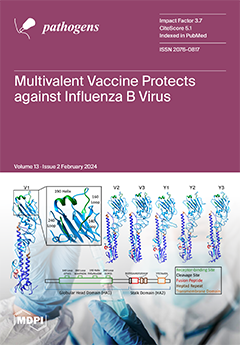Brucellosis and coxiellosis/Q fever are bacterial infections caused by
Brucella species and
Coxiella burnetii, respectively; camels are highly susceptible to both pathogens. Trichinellosis is a parasitic infection caused by various
Trichinella nematode species. Reportedly, camels are susceptible to experimental infection with
Trichinella
[...] Read more.
Brucellosis and coxiellosis/Q fever are bacterial infections caused by
Brucella species and
Coxiella burnetii, respectively; camels are highly susceptible to both pathogens. Trichinellosis is a parasitic infection caused by various
Trichinella nematode species. Reportedly, camels are susceptible to experimental infection with
Trichinella spp., but information on this potential host species is scarce. All three infections are of zoonotic nature and thus of great public health concern. The current study aimed to determine antibodies against the three pathogens in recently imported camels (n = 491) from Sudan at the two main ports for the entrance of camels into southern Egypt using commercial indirect ELISAs. Samples were collected in two sampling periods. The seropositivity rates of
Brucella spp.,
C. burnetii, and
Trichinella spp. were 3.5%, 4.3%, and 2.4%, respectively. Mixed seropositivity was found in 1% for
Brucella spp. and
C. burnetii. Marked differences were found between the two study sites and the two sampling periods for
Brucella. A higher rate of seropositivity was recorded in the Red Sea/older samples that were collected between 2015 and 2016 (4.3%, 17/391; odds ratio = 9.4;
p < 0.030) than in those collected in Aswan/recent samples that were collected between 2018 and 2021 (0/100). Concerning
C. burnetii, samples collected during November and December 2015 had a significantly higher positivity rate than the other samples (13%, 13/100; OD = 4.8;
p < 0.016). The same effect was observed for antibodies to
Trichinella spp., with samples collected during November and December 2015 showing a higher positivity rate than the other samples (7%, 7/100; OD = 10.9;
p < 0.001). This study provides valuable information on the seroprevalence of
Brucella spp. and additional novel information on
C. burnetii and
Trichinella spp. in recently imported camels kept in quarantine before delivery to other Egyptian regions. This knowledge can be utilized to reduce health hazards and financial burdens attributable to brucellosis, Q fever, and trichinellosis in animals and humans in Egypt.
Full article


